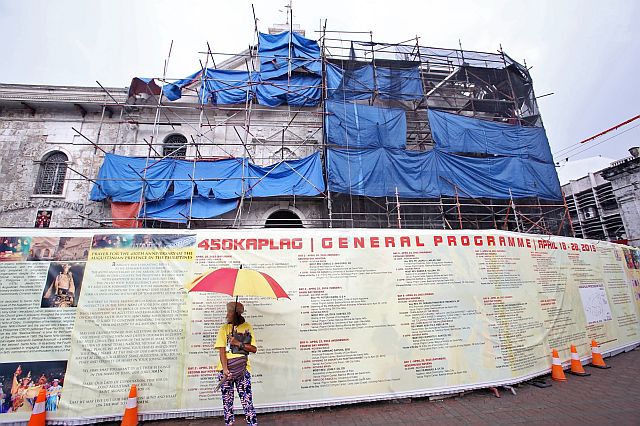
TIGHT SCHEDULE. Augustinian priests hope restoration work on the belfry and other parts of the Basilica Minore del Santo Niño damaged by the Oct. 15, 2013 quake is finished in time for January’s International Eucharistic Congress and the Sinulog
Piece by piece, Cebu’s historic churches are slowly being rebuilt two years after the Oct. 15 earthquake that shook provinces of Cebu and Bohol.
The slow work of restoration continues. For the Cebu Archdiocese, the big challenge lies in restoring the grandeur of places of worship in time for the 51st International Eucharistic Congress (IEC) scheduled in Cebu City from Jan. 24 to 31, 2016.
The Basilica Minore del Sto. Niño, Cebu’s oldest church, is still without a bell tower after the structure collapsed during the strong quake in the morning of Oct. 15, 2013.
Fr. Jonas Mejares, rector of the centuries-old basilica, said the contractor is doing everything to restore the belfry and refurbish the whole church before the IEC.
“We were assured that everything will be finished by December or early January next year. We’re really doing the best we can so that by the time the delegates visit the basilica, they would see its splendor,” Mejares said.
Reconstruction
The project of restoring the bell tower was awarded to Manila-based 401 Development and Construction Corp. which won the bidding in the middle of the year.
Reconstruction work, supervised by the National Historical Commission of the Philippines (NHCP), began last July.
Metal scaffoldings and braces were installed at the facade to shield people from falling debris as well as to support the remaining structures.
Workers are bleaching the walls to remove dirt and dark spots on the coral stones.
“We are taking steps to maintain the beauty of the basilica. We must take care of the entire structure for the benefit of the people,” he said.
While the basilica’s facade will follow the original design, he said not all seven bells will be reinstalled.
The biggest bell will no longer appear on the tower.
“Only the six smaller bells will be reinstalled there,” Mejares said.
The basilica is the home of the centuries-old wooden image of the child Jesus which was given as a baptismal gift by Portuguese explorer Ferdinand Magellan to Cebu’s Queen Juana in 1521.
Phases
The original church was founded in 1565, but the current structure, which is made of coral stones, was finished not later than 1739.
Aside from the Basilica del Sto. Niño, nine other churches in Cebu were damaged by the October 2013 earthquake.
These are the Cebu Metropolitan Cathedral in downtown Cebu City; Sto. Tomas de Villanueva Parish in barangay Pardo, Cebu City; St. Catherine de Alexandria Parish in Carcar City; St. Francis de
Assisi Parish in Dumanjug; Nuestra Señora del Pilar Parish in Sibonga; Archdiocesan Shrine of St. Michael the Archangel Parish in Argao; the San Guillermo de Aquitania Parish in Dalaguete;
Nuestra Señora de Patrocinio Parish in Boljoon; and St. Michael the Archangel Parish in Samboan.
Fr. Brian Brigoli, chairman of the Cebu Archdiocesan Commission on Culture and Heritage, said restoring the damaged churches has two phases.
The first phase involves a detailed study and various procedures to determine whether the church stands is still safe.
If the area is deemed stable, Brigoli said the actual restoration can begin.
So far, three churches—the cathedral, St. Catherine de Alexandria Parish in Carcar City, and the San Guillermo de Aquitania Parish in Dalaguete—have finished most of the restoration phase.
The process requires much patience.
“We need to study the whole structure very well first before carrying out the necessary intervention procedures,” he said.
Of the 10 damaged churches in Cebu, Brigoli said only four received financial assistance from the NHCP. The others had to raise their own funds for repair.
Those that received funding were the Basilica del Sto. Niño, Archdiocesan Shrine of St. Michael the Archangel Parish in Argao, St. Michael the Archangel Parish in Samboan, and St. Francis de Assisi Parish in Dumanjug.
Msgr. Ruben Labajo, team moderator of the Cebu Metropolitan Cathedral, said they relied on financial donations, second collections at Sunday Masses, and fund-raising events to gather resources to repair portions of the church that were damaged by the earthquake.
The cathedral, the ecclesiastical seat of the Archdiocese of Cebu, sustained major cracks on its facade and interior walls.
“We were told that the government could not provide us with financial help because we didn’t follow requirements such as submitting a a DES (Detailed Engineering Study),” he said.
The DES serves as a guide in a reconstruction work.
Labajo said the cathedral spent about P8 million to repair portions that were damaged by the earthquake.
He said they need another P8 million to beautify the cathedral and its premises in preparation for the IEC which is expected to bring about 15,000 national and foreign delegates to Cebu City.
“We appeal to people for help. Amid all these calamities, people never wavered in their faith. They are instead strengthened and inspired to unite for a cause. Yes, there are struggles, but in the end, we know a reward awaits us,” he said.